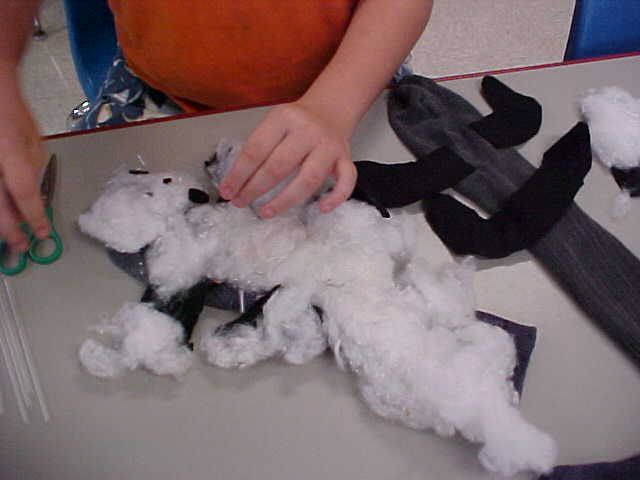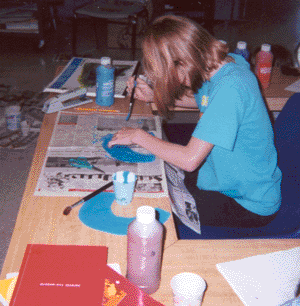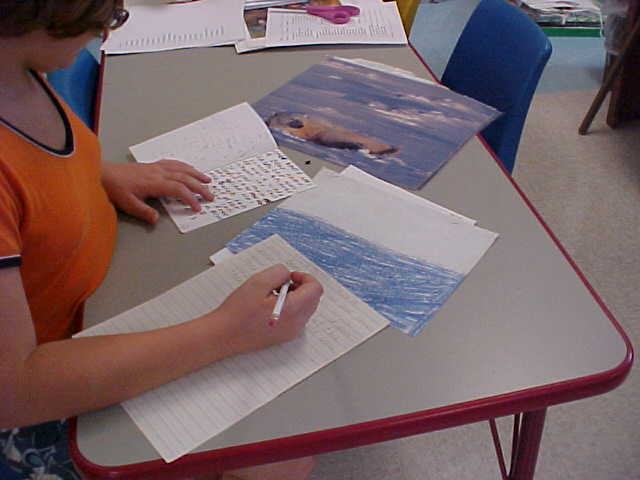|
Keeping Warm When it is Cold: How does a polar bear keep warm?
Adaptation in Nature
data
| hook
| main
| background & resources
| student
Author Contact Information
Author: Marilyn Cook
H. G. Olsen Elementary School
Port Aransas ISD
100 South Station St.
Port Aransas. Texas 78373
email: mjcook@paisd.net or mjcook@dorado.port-aransas.k12.tx.us
Overview
Overview: The students will be making a model of a polar bear and describing the color of the fur and skin and explaining why the color is important. Measuring the temperature of a black sock and a white sock and comparing temperatures is also included in the activity so that the students can see the difference between the two temperatures.
In the Arctic winter the predominant background color is white. The temperature is extremely cold so animals have adapted for survival. The polar bear looks white and this adaptation protects the bear from being seen by predators. The polar bear’s top fur is actually transparent, hollow hair shafts. There is a dense ‘woolly’ undercoat. The bears also have a layer of blubber under their skin. Air is trapped in the hollow hair shafts and this provides insulation for the bears. The hairs reflect light so that the color of the bear looks white. The hair does not mat so that ice and water can be shaken off easily. The polar bear’s skin is black. Black absorbs light wavelengths so that the skin absorbs the warmth from the light and holds it instead of reflecting it away from the skin.
Objective: The student will be able to describe orally and in writing how the polar bear has adapted to the Arctic environment.
Grade Level/Discipline
Grade level: 1-3 life science (This lesson can be used in upper elementary grades with appropriate fiction and nonfiction texts and these texts could be read to kindergarten students as an integrated science and language arts lesson.)
National Standards
National Science Standards: K-4 Life Science-characteristics of organisms, organisms and environments: 5-8 Life Science-diversity and adaptations of organisms measurement
Pre-activity set-up
Teacher prep: this lesson is designed to be conducted when it is winter in Alaska- read info about Arctic winter and climate, animal adaptation in Arctic, make model so that you can read story to students with the model (directions below in the explanation section)(See resources section for suggested background material)
Materials
Materials: black, white socks (garage sales, thrift stores, do not have to be new) for each student, clear plastic stirring straws cut in 4cm lengths, glue gun, cotton roll, black felt (for eyes, nose,ears, legs), pictures of polar bears from web or book (calendars, websites), thermometers that measure Celsius, world map and/or globe, Polar Bear, Polar Bear What Do You Hear? by Bill Martin (or any appropriate fiction book about a polar bear), paper and pencil or a science journal (simple folded paper with construction paper cover or purchased journal)
Time Frame
Time frame: 2 days-3 days, 45 minutes each day
Engagement and Exploration (Student Inquiry Activity)
Before beginning this activity, have students make a prediction about how polar bears keep warm. Please refer to hook section of this lesson.
Engagement: Take the temperature outside the school building and write it on chart. Ask students questions such as: What is the temperature? What type of clothing are they wearing? Does the temperature have anything to do with what they are wearing? Why would the temperature make a difference in what they might wear? In choosing what to wear to school did any one check the temperature? Next ask students to name some areas where it is cold in the winter. If students do not mention Alaska or the Arctic suggest these areas and ask students to find Alaska and the Arctic region on a globe or map. Ask them what they think the temperature would be in Alaska at that time. Go to the NOAA site on the web(see resources section for link)and check the temperature in Nome, Alaska, write it on the chart. Ask what type of clothing the students would be wearing if they were in Alaska or the Arctic region. Read children’s book, Here is the Arctic Winter , ask questions and fill out a KWLQ chart (K-What I Know, W-What I Want to Know, L-What I Learned, Q-Questions I Still Have)
Explanation (Discussing)
Explanation: Explain to the students that they will be making a model of a polar bear, as well as describing the polar bear, explaining what it looks like, and how it keeps warm when it is cold by writing about the bear, making a drawing of the bear and labeling the drawing.
Have materials set out and let students choose what color of sock with which to make the model (do not tell students what color to use so that they can discover what the correct color would be after doing the temperature activity).

With the class fill out the KWLQ chart-what they know about polar bears, what they would like to know about polar bears and how polar bears keep warm, next have students look at books and/or websites to view photos of polar bears
After students have assembled their materials and before making the bear model have students form groups of 4 and then have them take the therometers and socks outside with them (if raining or weather is such that you cannot go outside have a heat lamp available to simulate sun and follow all safety precautions with the lamp) Ask students to predict which would keep them warmer: white or black socks? Students put a white sock on one hand and a black sock on the other hand and after 5 minutes ask which is warmer. Students take off the socks and put a thermometer in each sock leaving a few cm out of the sock so that the temperature can be read. After 5 minutes the students read the temperatures and record on a chart that has the word "temperature" written at the top with 2 columns formed underneath the word "temperature". One column is for recording the temperature of the white sock and the other column is for recording the temperature of the black sock.

Students return to classroom and after reading the chart of temperatures, look to see if there is a difference in the recorded temperatures. Ask students if their prediction was correct. Ask if this information would change their sock selection for the model. Why or why not?
To make model each student takes the sock and adds legs, tail (cut from black felt) by using glue to attach the pieces to the sock in appropriate places. Next the students take white cotton and add it to the sock with glue. After that the student cuts clear plastic stirring straws in 4cm lengths and glues them very close together to each other in rows. When straws are dry the student cuts out small pieces of black felt for ears,eyes, nose, and glues those pieces on the head (toe of sock). After student has made model, she/he draws a polar bear and labels the parts such as head, hair, skin, eyes, earsnose,tail, legs, etc. Student writes 4-5 sentences explaining how the polar bear keeps warm in the Arctic winter with these terms included in the description-"heat absorption", "adaptation", "color of skin"
Elaboration (Polar Applications)
Elaboration: As a class add comments to the KWLQ chart and ask if what they know has changed about a polar bear. Students will then look up word “adaptation” in dictionary, glossary or other reference and write the meaning on a card to use as a label in the drawing they will make. The meaning of the word “adaptation” may be added to the KWLQ chart. Students may also draw a "habitat" for their model using construction paper, pencils, etc.

Exchange (Students Draw Conclusions)
Evaluation (Assessing Student Performance)
Evaluation: After the students makes model, each student draws a polar bear and labels the parts ( head, hair, skin, eyes, nose tail, etc.) Student writes 4-5 sentences explaining how the polar bear keeps warm in the Arctic winter with these terms included in their description: “heat absorption", "color of skin" and “adaptation”. Sample questions students need to answer include: Where does the polar bear live? What color of skin does it have? Why? How does it help the polar bear keep warm? What is “coloration” for an animal? What does adaptation mean? What would you wear if you were in the Arctic in the winter? Could a polar bear live in (put in your location)? Would you wear a black shirt to the beach in the summer (or in your locale), if the temperature was 33C degrees and sunny? Students add other questions they may still have about polar bears to the KWLQ chart and then list where they may find answers. Students compare what they found out during the lesson with their original prediciton in their science journals. This then can become the basis of a report about polar bears. Students may also want to write a fiction text about polar bears using the narrative text as examples.

data
| hook
| main
| background & resources
| student
|





